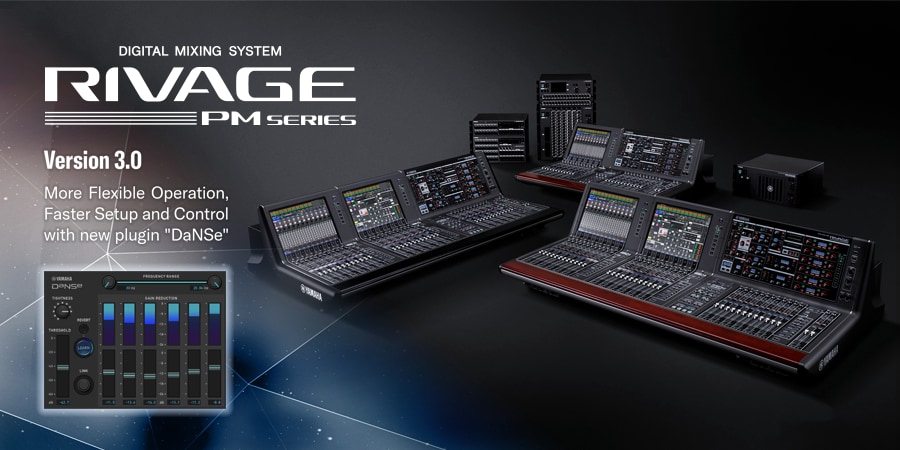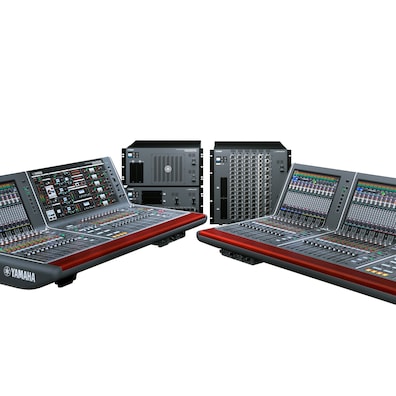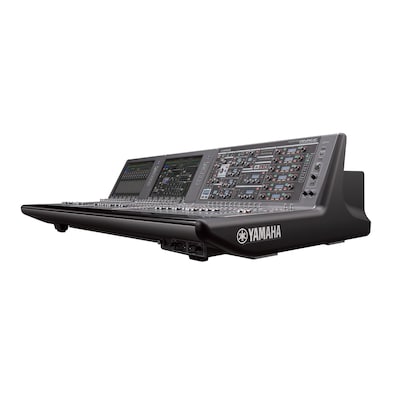RIVAGE PM Series Firmware V3.0 - More Flexible Operation, Faster Setup and Control

February 4, 2019. Shizuoka, Japan. - Continuing the sequence of regular updates that have been rolled out since the RIVAGE PM series digital mixing systems were first released, Yamaha is pleased to announce the arrival of update version 3.0. In addition to a new noise-reduction plugin, update version 3.0 offers improved routing freedom as well as generally enhanced flexibility. A number of operation and visual feedback refinements requested by users have also been included. The overall result is a stress-free operating environment for engineers who need to manage large-scale systems and complex events.
Expanding the already comprehensive plugin lineup provided with RIVAGE PM series digital mixing systems, a new dynamic noise suppressor developed by the renowned Dr. K and his K’s Lab team is included in V3.0. The “DaNSe” plugin analyzes noise frequency characteristics and employs a LEARN function to automatically achieve the most effective noise suppression without the need for any complex setup or programming by the user. DaNSe is ideal for use with speech and lavalier microphones, effectively suppressing air conditioning noise and noise produced by cooling fans in on-stage moving lights, for example. Effective noise suppression can be a significant advantage for plays and musicals, significantly enhancing audio clarity.
The ability to route MIX bus and MATRIX signals back to the input channels improves routing flexibility, making parallel compression and multi-layer mixes using stem mixes possible for more detailed mixing and sound shaping capability. Cascade connection via SUB IN is also now possible, making higher input capacities available for large-scale applications. Other refinements make it easier to manage the many parameters available in the RIVAGE PM series. Not only is finer granularity provided for channel copy, but multiple data sets can now be maintained. Plugins settings can now be included in input and output channel copy and paste operations, and eight banks are available for storing frequently used global paste setups. More detailed recall safe/focus settings are also provided to facilitate more complex scene management and operation.
To promote safe, error-free system operation, an alert is displayed if the user attempts to load data that differs from the current system configuration, and the differences can be reviewed before the data is actually loaded to preempt potentially serious problems before they occur. Furthermore, the amount of latency that will be added for each setting when using delay compensation can be easily confirmed, so the engineer can make appropriate settings according to the specific applications and total system latency.
To increase the system’s utility for monitor console use, it is now possible to assign the ON keys to either conventional SEND ON/OFF switching or input channel ON/OFF switching in the SENDS ON FADER mode. This makes it possible to instantly mute the relevant input channels during instrument changes or when a problem occurs by simply turning them OFF, and to turn wedge and In-ear monitor sends OFF as required by the situation. For theatrical productions and musicals, DCA assignments can be quickly made for each scene by creating DCA presets with the appropriate channel assignment, DCA name, and color icon settings. Preliminary DCA settings can be quickly and flexibly changed during rehearsals as the need arises. A new CH ON FOLLOWS DCA ASSIGN function automatically turns channels ON or OFF according to DCA assignments, further enhancing control convenience.
Related software applications have also received corresponding refinements, with the RIVAGE PM Editor gaining multi-window support. Up to three windows can be active simultaneously, making it possible to edit multiple channels or bays at the same time. The RIVAGE PM StageMix app now allows control of input patching, DCA/MUTE groups, and insert effects, in addition to providing full-screen input/output metering. All of these evolved tools can significantly increase operating speed and ease.
According to Yoshi Tsugawa, general manager of the Yamaha pro audio division, “RIVAGE PM series digital mixing systems have acquired an enviable reputation for their unrivalled sonic quality, features, and operability, and their adoption by large-scale concert tours, musical theatres, and halls continues at a rapid pace. Feedback from such demanding users has been taken into careful consideration and applied in RIVAGE PM V3.0, resulting in a large number of new features that deliver unprecedented flexibility for a wide range of applications. Sound engineers will benefit from greatly enhanced efficiency, particularly for jobs that involve complex control and a large number of inputs and outputs.”


